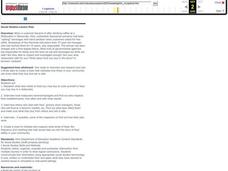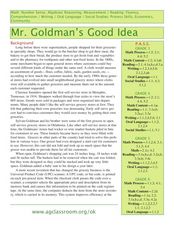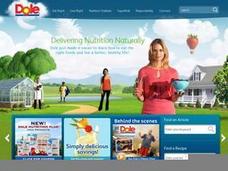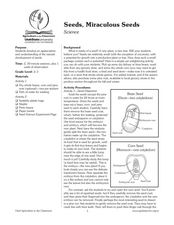Curated OER
McDonald's and 'Spiked' Coffee
Students explore food safety. Pupils research what laws relate to food you cook yourself, food you may buy in a restaurant and food bought in a grocery store. They interview food inspectors. Students create a chart to indicate who...
Curated OER
Mr. Goldman's Good Idea
Shopping carts are a modern convenience that many people take for granted. Make sure your pupils do not fall into that category by completing the activities in this plan. There are ideas included for language arts, social studies, math,...
Curated OER
Fur, Feathers and Fins
Students examine the stages between growing the animal and buying it at the grocery store. In food system lesson students study the role that animal products have on nutrition and study animal agriculture.
Curated OER
A Visit to Price Chopper
Students visit the grocery store to purchase items to make trail mix which are connected to Kansas agriculture. They problem solve to determine which products to buy, then create, advertise and sell the trail mix to the student body...
Curated OER
Labelling
Young scholars assess the difference between "use by" and "best before" date markings on food items bought at a grocery store or some other establishment. They determine whether or not stored food is safe to eat and practice developing...
Perkins School for the Blind
The Price is Right
Go on a shopping trip to practice estimation, price value, and shopping skills. The class heads off to the market to purchase several items for the activity. While they are there, they discuss the cost of various foods and even...
Curated OER
Making Choices to Save Money on Food
Young scholars review lists of coupons and complete a worksheet to analyze the benefits of the specials. In this household budget instructional activity, students determine which foods are nutritional and the advantages of using coupons...
Curated OER
Introduce Vocabulary: George's Store at the Shore
Young scholars explore vocabulary words from the story. In this language arts lesson, students discuss vocabulary words from the story. Young scholars discuss the word meanings and use the words in sentences.
Houghton Mifflin Harcourt
Silly Stories: English Language Development Lessons (Theme 1)
ESL/ELD learners are provided extra support with the Houghton Mifflin Harcourt thematic units on silly stories by this packet of activities, exercises, and practice sets.
Curated OER
Cost Comparison
Students take a tour of a produce department in a grocery store. They explore the concepts of money and a budget. They complete problem solving activities and taste different fruits and vegetables.
Curated OER
BY THE POUND
The student will estimate the weight and cost of produce and calculate the actual price.Discuss the difference between weight and volume. Have students discuss whether it is more economical to buy produce by the pound, by the piece or...
Curated OER
Seeds, Miraculous Seed
Students investigate relationships between plants and animals and how living things change during their lives. In this life cycle activity, students split different types of seeds apart to see the beginning life stages of future plants.
Curated OER
Ag Pays
Second graders understand that may jobs relate to agriculture. In this agriculture lesson, 2nd graders role play several agricultural jobs and the goods associated with them. Students may contact a community member with that job.
Curated OER
Apple Kinds to Products
Students become familiar with various kinds of apples and the tree they grow on. In this Apple tree lesson, students recognize the differences between apples and can identify what happens to apples in different seasons. ...
Curated OER
Beanie Baby
Students will explain the importance of soybeans. In this science lesson, students participate in making a "beanie baby" necklace. Additionally, students observe their soybeans for germination and growth for 7-10 days. Students record...
Curated OER
Microbes and Health
Students participate in activities that show them how tiny germs are spread. In this germs lesson plan, students engage in hands on lessons to show them how microorganisms can easily spread disease through the mouth and hands.
Curated OER
Can You Measure Up!
Seventh graders investigate standards of measurement and metric units using a game to show the importance of standards of measurements. In this measuring lesson plan, 7th graders are grouped together and each group represents a foreign...
Curated OER
Breaking News English: Supermarkets
In this supermarkets worksheet, students read the article, answer true and false questions, complete synonym matching, complete phrase matching, complete a gap fill, answer short answer questions, answer discussion questions, write, and...
Curated OER
Data Analysis and Bias
For this probability and statistics worksheet, students determine when a collected data or a graph of the data could be biased. The one page worksheet contains four multiple choice questions. Answers are included.
Curated OER
Better Butter
Students explore the process of making butter. In this agriculture lesson, students discuss how butter is made today and how it was made in the past. Students make their own butter using baby food jars and some "elbow grease."
Curated OER
Career & Technology Education Introduction to Farming: Seeds of Successful Marketing
Learners play an agronomy game. For this agriculture lesson plan, students explore modern farming practices pertaining to the cultivation of grains as they play a game that requires them to act as agronomy specialist as they...
Curated OER
How Far Did It Travel?
Sixth graders read and discuss background and vocabulary. They use the background to develop a flow chart showing the movement of food from farm to table and work independently or in groups to complete an activity. They then use Internet...
Curated OER
Money Matters
Pupils explore the concept of money. In this money lesson, students role play an economy. Pupils are divided into three categories- the money factory, construction workers, and the grocery store. Students work cooperatively to make the...
K12 Reader
Object Pronouns
Take a stab at object pronouns with a straightforward exercise. Give an object, learners determine which object pronoun would be most appropriate to finish 25 sentences.

























